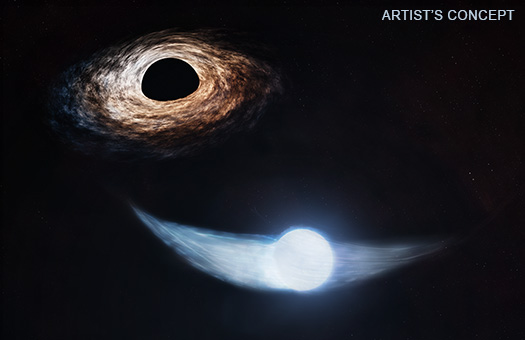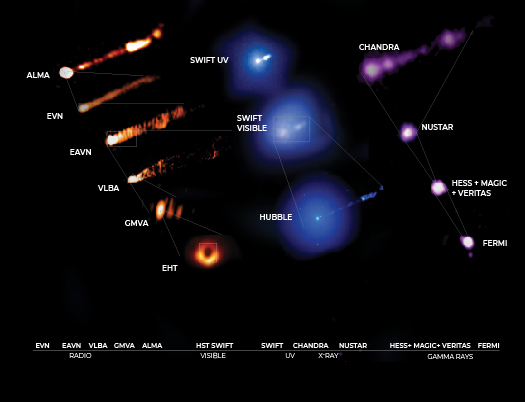Chandra Sees Black Hole Jet Stumble Into Something in the Dark
Submitted by chandra on Tue, 2024-12-10 13:45Even matter ejected by black holes can run into objects in the dark. Using NASA’s Chandra X-ray Observatory, astronomers have found an unusual mark from a giant black hole’s powerful jet striking an unidentified object in its path.
The discovery was made in a galaxy called Centaurus A (Cen A), located about 12 million light-years from Earth. Astronomers have long studied Cen A because it has a supermassive black hole in its center sending out spectacular jets that stretch out across the entire galaxy. The black hole launches this jet of high-energy particles not from inside the black hole, but from intense gravitational and magnetic fields around it.
Black Hole Destroys Star, Goes After Another, NASA Missions Find
Submitted by chandra on Tue, 2024-10-08 15:36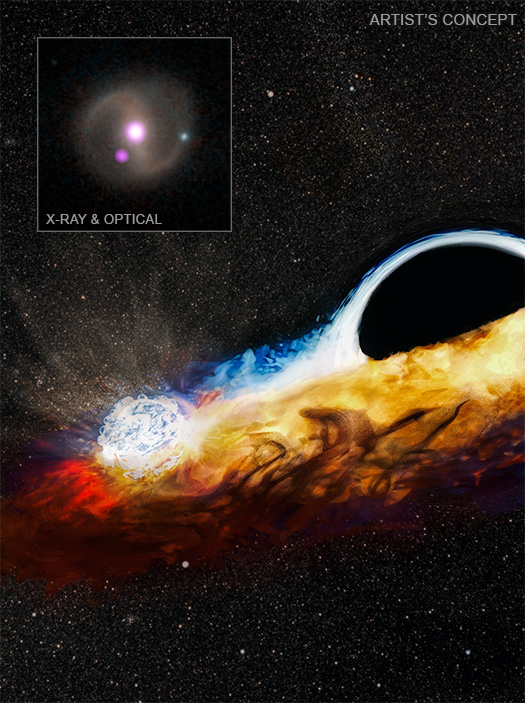
AT2019qiz
Credit: X-ray: NASA/CXC/Queen's Univ. Belfast/M. Nicholl et al.; Optical/IR: PanSTARRS, NSF/Legacy Survey/SDSS; Illustration: Soheb Mandhai / The Astro Phoenix; Image Processing: NASA/CXC/SAO/N. Wolk
NASA’s Chandra X-ray Observatory and other telescopes have identified a supermassive black hole that has torn apart one star and is now using that stellar wreckage to pummel another star or smaller black hole, as described in our latest press release. This research helps connect two cosmic mysteries and provides information about the environment around some of the bigger types of black holes.
This artist’s illustration shows a disk of material (red, orange, and yellow) that was created after a supermassive black hole (depicted on the right) tore apart a star through intense tidal forces. Over the course of a few years, this disk expanded outward until it intersected with another object — either a star or a small black hole — that is also in orbit around the giant black hole. Each time this object crashes into the disk, it sends out a burst of X-rays detected by Chandra. The inset shows Chandra data (purple) and an optical image of the source from Pan-STARRS (red, green, and blue).
NASA Telescopes Work Out Black Hole's Snack Schedule
Submitted by chandra on Tue, 2024-08-13 12:39How do Supermassive Black Holes Get Super Massive?
Submitted by chandra on Mon, 2024-06-10 17:34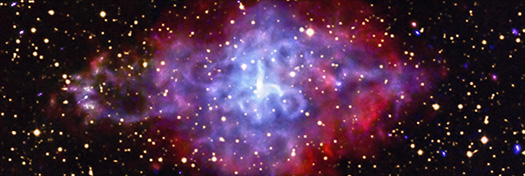
3C 58
Credit: X-ray: NASA/CXC/ICE-CSIC/A. Marino et al.; Optical: SDSS; Image Processing: NASA/CXC/SAO/J. Major
The supernova remnant 3C 58 contains a spinning neutron star, known as PSR J0205+6449, at its center. Astronomers studied this neutron star and others like it to probe the nature of matter inside these very dense objects. A new study, made using NASA’s Chandra X-ray Observatory and ESA’s XMM-Newton, reveals that the interiors of neutron stars may contain a type of ultra-dense matter not found anywhere else in the Universe.
In this image of 3C 58, low-energy X-rays are colored red, medium-energy X-rays are green, and the high-energy band of X-rays is shown in blue. The X-ray data have been combined with an optical image in yellow from the Digitized Sky Survey. The Chandra data show that the rapidly rotating neutron star (also known as a “pulsar”) at the center is surrounded by a torus of X-ray emission and a jet that extends for several light-years. The optical data shows stars in the field.
Unexpectedly Calm and Remote Galaxy Cluster Discovered
Submitted by chandra on Tue, 2023-07-18 13:52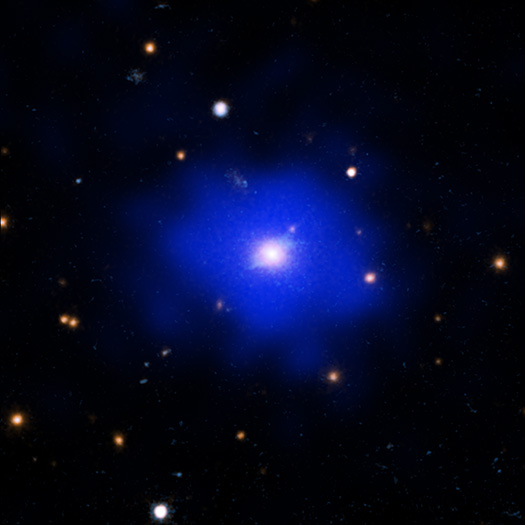
Credit: X-ray: NASA/CXC/MIT/M. Calzadilla; UV/Optical/Near-IR/IR: NASA/STScI/HST; Image processing: N. Wolk
The discovery of the most distant galaxy cluster with a specific important trait – as described in our press release – is providing insight into how these gigantic structures formed and why the universe looks like it does in the present day.
'H' is for Hot and Huge in Chandra Image
Submitted by chandra on Wed, 2023-05-03 14:43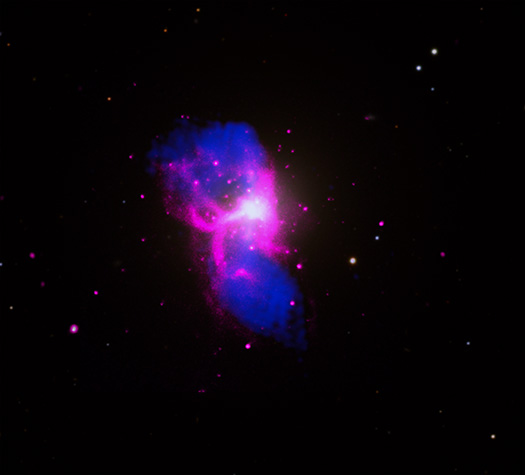
M84
Credit: X-ray: NASA/CXC/Princeton Univ/C. Bambic et al.; Optical: SDSS; Radio: NSF/NRAO/VLA/ESO; Image processing: NASA/CXC/SAO/N.Wolk
With a single letter seemingly etched in the X-ray glow around it, a giant black hole at the center of a massive elliptical galaxy is making a mark on its surroundings.
This “H”-shaped structure is found in a detailed new X-ray map of the multimillion-degree gas around the galaxy Messier 84 (M84).
As gas is captured by the gravitational force of the black hole, some of it will fall into the abyss, never to be seen again. Some of the gas, however, avoids this fate and instead gets blasted away from the black hole in the form of jets of particles. These jets can push out cavities, in the hot gas surrounding the black hole. Given the orientation of the jets to Earth and the profile of the hot gas, the cavities in M84 form what appears to resemble the letter “H.” The H-shaped structure in the gas is an example of pareidolia, which is when people see familiar shapes or patterns in random data. Pareidolia can occur in all kinds of data from clouds to rocks and astronomical images.
Centaurus A Shines in New Image from NASA's Chandra and IXPE
Submitted by chandra on Mon, 2023-05-01 11:46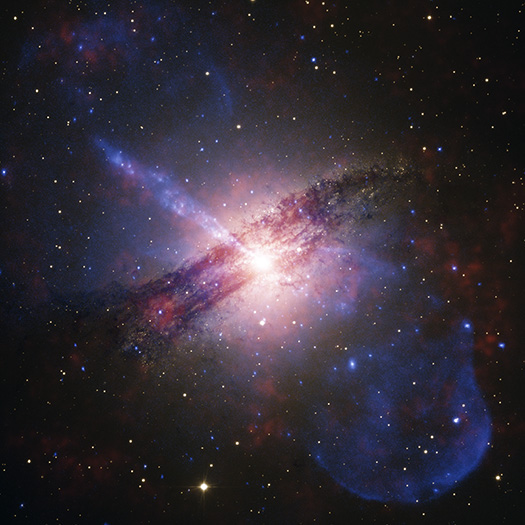
Centaurus A
Credit: X-ray: (IXPE): NASA/MSFC/IXPE/S. Ehlert et al.; (Chandra): NASA/CXC/SAO; Optical: ESO/WFI; Image processing: NASA/CXC/SAO/J.Schmidt
The galaxy Centaurus A (Cen A) shines bright in this image combining data from multiple observatories. In the center of this galaxy is a supermassive black hole feeding off the gas and dust encircling it, and large jets of high-energy particles and other material spewing out. The jet shown at the upper left of this image extends for about 13,000 light-years away from the black hole. Also visible is a dust lane, wrapping around the middle of the galaxy, which may have resulted from a collision with a smaller galaxy millions of years ago.
Colors in this image have been chosen to reflect the sources of data. Blue shows X-ray light captured by NASA’s Chandra X-ray Observatory, orange represents X-rays detected by NASA’s Imaging X-ray Polarimetry Explorer (IXPE) satellite, and optical light seen by the European Southern Observatory in Chile is colored white and gray.
Chandra's Indirect Glance into the Early Universe: Merging Dwarf Galaxies and their AGN
Submitted by chandra on Fri, 2023-02-17 14:49We are pleased to welcome Marko Mićić as a guest blogger. Marko led the study that is the subject of our latest press release [link to PR]. He graduated from the University of Belgrade, Serbia, with a degree in Astronomy and Astrophysics, in 2018. The same year he started a Ph.D. at the University of Alabama, and has been working under Dr. Jimmy Irwin's supervision since then. His research interests include evolution of low-mass galaxies, AGN content of low-mass galaxies, intermediate-mass black holes and gravitational lenses.
Galaxies are made up of billions of stars, interstellar gas and dust, and large amounts of dark matter. Every (or almost every) galaxy is expected to host a supermassive black hole in its center. Galaxies and their central black holes grow and evolve together predominantly through mergers; smaller objects merge to create larger ones over time. However, the earliest stages of galaxy evolution involving the mergers of the first galaxies are poorly understood. It is unclear how the first mergers affected the morphology of ancient galaxies and their star formation. We also do not know how massive the first black holes were that inhabited the first galaxies, nor how the first mergers influenced their ability to accrete – pull in – material.
It is challenging to answer these important questions because the first mergers are too distant and faint to be directly observed. One way to overcome this issue is to look for local analogs. In other words, we need to find pairs of small, dwarf galaxies that have had very quiet lives, with almost no mergers, that have only recently met and started interacting. Such galaxies have experienced little to no evolution so they are analogs of distant, ancient galaxies, and observations of their mergers would represent the local case study that illustrates the hierarchical growth of structures in the early Universe. Their central black holes are also expected not to have grown much and preserve information about primordial seeds, potentially holding the key to resolving the outstanding problem of the origin of supermassive black holes.
"X-ray Magnifying Glass" Enhances View of Distant Black Holes
Submitted by chandra on Mon, 2021-08-30 12:46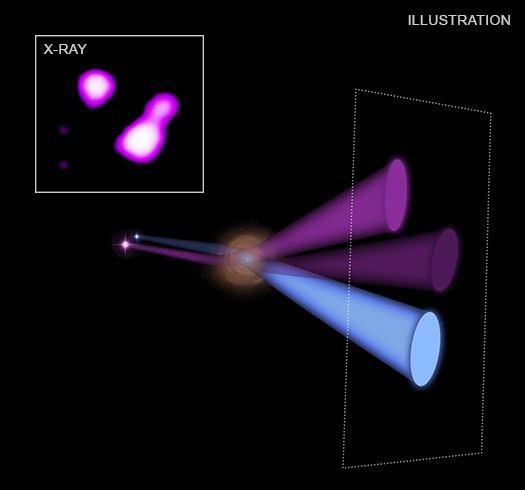
Gravitationally-Lensed System MG B2016+112
Credit: Illustration: NASA/CXC/M. Weiss; X-ray (inset): NASA/CXC/SAO/D. Schwartz et al.
A new technique using NASA's Chandra X-ray Observatory has allowed astronomers to obtain an unprecedented look at a black hole system in the early Universe, as reported in our latest press release. This is providing a way for astronomers to look at faint and distant X-ray objects in more detail than had previously been possible.
Astronomers used an alignment in space that shows "gravitational lensing" of light from two objects that are nearly 12 billion light years away. An artist's illustration in the main part of this graphic shows how the paths of light from these distant objects are bent and amplified by a galaxy along the line of sight between Earth and the objects.
Telescopes Unite in Unprecedented Observations of Famous Black Hole
Submitted by chandra on Wed, 2021-04-14 06:31In April 2019, scientists released the first image of a black hole in the galaxy M87 using the Event Horizon Telescope (EHT). This supermassive black hole weighs 6.5 billion times the mass of the sun and is located at the center of M87, about 55 million light-years from Earth.
The supermassive black hole is powering jets of particles that travel at almost the speed of light, as described in our latest press release. These jets produce light spanning the entire electromagnetic spectrum, from radio waves to visible light to gamma rays.
To gain crucial insight into the black hole's properties and help interpret the EHT image, scientists coordinated observations with 19 of the world's most powerful telescopes on the ground and in space, collecting light from across the spectrum. This is the largest simultaneous observing campaign ever undertaken on a supermassive black hole with jets.
The NASA telescopes involved in this observing campaign included the Chandra X-ray Observatory, Hubble Space Telescope, Neil Gehrels Swift Observatory, the Nuclear Spectroscopic Telescope Array (NuSTAR), and the Fermi Gamma-ray Space Telescope.
Pages
Please note this is a moderated blog. No pornography, spam, profanity or discriminatory remarks are allowed. No personal attacks are allowed. Users should stay on topic to keep it relevant for the readers.
Read the privacy statement


